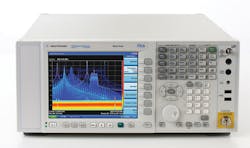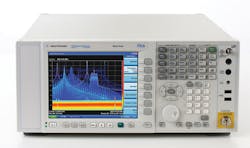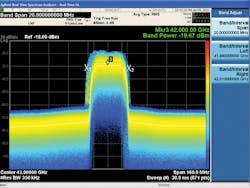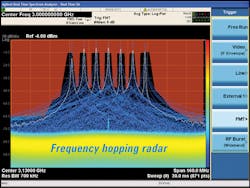Real-Time Analyzers Grab 50-GHz Signals
High-frequency signals grow more elusive with time, making the task of a spectrum or signal analyzer to capture them more challenging with each new generation of commercial and military electronic systems. In response to the increasing agility of modern signals, the PXA X-Series signal analyzers with real-time spectrum analysis (RTSA) from Agilent Technologies provide the measurement capabilities needed to accurately and reliably view such signals, and within a measurement range of 50 GHz. These analyzers can record and study a wide range of signals, from extremely short and intermittent signals to traditional sine waves, with a high probability of intercept (POI).
PXA X-Series models are available with real-time spectrum analysis bandwidths as high as 85 and 160 MHz. In addition, they can capture low-level signals with sensitivity of -157 dBm at 10 GHz, without the assistance of an additional preamplifier. These RTSAs are equipped to record and play back the most short-term and complex modulated signals found in modern commercial, industrial, and military electronics systems and their components—even when those signals are designed to be difficult to detect.
Of course, the term “real time” can have a variety of meanings. It is probably best associated with a digital sampling oscilloscope but, as seen with the PXA instruments, can also be applied to spectrum analysis. Agilent offers a thorough education on what “real time” means in terms of the company’s instruments on its website. In essence, a real-time analyzer is capable of providing calculation and acquisition speeds that are fast enough to deliver gap-free analysis of measured data that has been sampled or captured with a data converter. In the case of the real-time PXA X-Series analyzers, the gap-free analysis is extended across impressive bandwidths of 85 and 160 MHz.
These RTSA capabilities are available with a new purchase of N9030A PXA signal analyzer (Fig. 1), or can be added as upgrade options to existing PXA signal analyzers, with the N9030AK-RT1 upgrade supporting real-time spectrum analysis at bandwidths to 85 MHz and the N9030AK-RT2 upgrade enabling real-time spectrum analysis at bandwidths to 160 MHz. Analyzer models are available for frequency ranges spanning 3 Hz to 3.6, 8.4, 13.6, 26.5, 43, 44, and 50 GHz, and can be extended to 325 GHz and beyond by means of external mixing. This is the first time that real-time analysis capability has been available as an upgradeable option to a “conventional” signal analyzer, such as one of the PXA instruments. This offers laboratories and other facilities the flexibility to add the real-time measurement capability as needed.
1. The PXA X-Series signal analyzers are available with real-time analysis bandwidths of 85 or 160 MHz for center frequencies from 3.6 to 50 GHz.
Guy Séné, President of Agilent’s Electronic Measurement Group, notes that “a high-performance analyzer should be ready for anything—and that’s why the RTSA is an upgrade option to the PXA.” He adds that “only the real-time PXA combines a high-performance signal analyzer and real-time analysis. It gives users greater confidence that they’ve achieved a detailed understanding of what’s happening inside a signal-rich system or environment.” These analyzers are actually more like complete measurement systems than individual instruments because of the extent of their over 25 embedded measurement applications, which include noise-figure measurements, phase-noise measurements, and analysis of pulsed and modulated signals.
The real-time PXA analyzers deliver outstanding measurement performance by leveraging both hardware and software within each instrument. They promise a 100% POI for signals as brief as 3.57 μs with full amplitude accuracy. Coupled with their wide analysis bandwidths and low noise characteristics, these analyzers can detect and isolate even short-term, low-level signals from relatively noisy signal environments; this includes signals surrounded by higher-level jammers and interference signals. The analyzers boast internal single-sideband (SSB) phase noise of -132 dBc/Hz offset 10 kHz from a 1-GHz carrier. They also provide third-order-intermodulation (TOI) distortion of +22 dBm at 1 GHz as evidence of an extremely wide measurement dynamic range.
With a spurious-free dynamic range (SFDR) of 75 dB, each analyzer can detect and display extremely small signals in the presence of large signals across analysis bandwidths as wide as 160 MHz. The reference level for a real-time PXA X-Series analyzer can be set from -170 to +30 dBm in 0.01-dB steps in the log scale and from 707 pV to 7.07 V with 0.11% (0.01 dB) resolution in the linear scale.
The PXA analyzers offer excellent amplitude accuracy of ±0.19 dB for a wide range of signal levels. Furthermore, that 160-MHz analysis bandwidth (Fig. 2) brings with it exceptional amplitude performance and phase linearity to minimize internal errors for vector signal analysis as well as for real-time spectrum analysis. The analyzers also offer some software tools to assist with more challenging measurements, such as the noise-floor-extension (NFE) technology. The NFE functionality reduces measurement noise by as much as 10 dB. Using the NFE feature and a preamplifier, each analyzer can achieve a displayed average noise level (DANL) of -172 dBm at 1 GHz.
2. The real-time PXA X-Series analyzers can capture a span of signals as wide as 160 MHz at center frequencies as high as 50 GHz.
The NFE technology is based on the fact that 90% or more of each instrument’s contributed noise power is predictable and can be measured, calibrated, and eliminated as part of a normal measurement procedure. Using the NFE technology, for example, helps achieve a wideband-code-division-multiple-access (WCDMA) adjacent-channel leakage ratio (ACLR) dynamic range of nominally -88 dBc when evaluating WCDMA cellular systems and their components.
In terms of measurement capability, these real-time PXA analyzers can make zero-span as well as swept and Fast Fourier Transform (FFT) mode measurements across their various frequency ranges. Each analyzer includes a frequency counter with marker resolution of 0.001 Hz. For zero-span measurements, sweep times can be adjusted from 1 μs to 6000 s. In addition to traditional zero-span analysis, the PXA also offers a wideband, gap-free power-versus-time display that enables users to view and measure short-duration pulses with fast rise/fall times in the time domain. For frequency spans of greater than 10 Hz, sweep times can be set from 1 ms to 4000 s. Trigger delays for zero-span measurements can be set from -150 to 500 ms. For spans greater than 10 Hz, trigger delays can be set from 0 to 500 ms, with resolution 0.1 μs.
Measurements can be made with resolution bandwidths set from 1 Hz to 3 MHz in 10% steps, and with resolution bandwidths of 4, 5, 6, and 8 MHz. The bandwidth accuracies of these resolution-bandwidth filters is within ±1% for resolution bandwidths to 1 MHz; ±0.07% for resolution bandwidths from 1.1 to 2.0 MHz; ±0.10% for resolution bandwidths from 2.2 to 3.0 MHz; and ±}0.20% for resolution bandwidths from 4 to 8 MHz.
The analyzers are available with a number of useful options for traditional signal analysis. For example, for facilities concerned with electromagnetic-compatibility (EMC) testing, the PXA X-Series analyzers can be equipped with option EMC for accurate, standards-based electromagnetic-interference (EMI) measurements. The option supports Comite International Special des Perturbations Radioelectriques (CISPR) standards for compliant EMI bandwidths of 200 Hz, 9 kHz, 120 kHz, and 1 MHz. Also supported are EMC measurements compliant to MIL-STD-461E requirements at bandwidths of 10 Hz, 100 Hz, 1 kHz, 10 kHz, 100 kHz, and 1 MHz.
The analyzers are available with video bandwidths of 1 Hz to 3 MHz in 10% steps, and 4, 5, 6, and 8 MHz with ±6% nominal accuracy in swept measurement mode and for zero-span measurements. Optional preamplifiers can be specified for frequency ranges of 9 kHz to 3.6 GHz, 9 kHz to 8.4 GHz, 9 kHz to 13.6 GHz, 9 kHz to 26.5 GHz, 9 kHz to 43 GHz, 9 kHz to 44 GHz, and 9 kHz to 50 GHz, with 20-dB gain to 3.6 GHz, 35-dB gain from 3.6 to 26.5 GHz, and 40-dB gain from 26.5 to 50 GHz.
These high-performance signal analyzers include mechanical input attenuators to help boost the effect dynamic measurement range. The input attenuators cover a range of 0 to 70 dB in 2-dB steps for frequencies from 3 Hz to 50 GHz. As an option (EA3), the analyzes can also be outfit with an electronic attenuator with frequency range of 3 Hz to 3.6 GHz with range of 0 to 24 dB in 1-dB steps. When combined with the mechanical input attenuator, the total attenuation range is 0 to 94 dB in 1-dB steps. The real-time spectrum analyzers can handle maximum safe input levels to +30 dBm (1 W) with or without their optional preamplifier. The can work with peak pulse power levels as high as +50 dBm (100 W) for pulse widths of less than 10 μs and less than 1% duty cycle and at least 30-dB input attenuation applied.
Every PXA includes in-phase/quadrature (I/Q) analyzer functionality and Agilent PowerSuite for analysis of captured signals; in addition, captured signals can be transferred to RF/microwave signal generators for further use in testing, or to mathematics or high-frequency software simulation tools, such as the Agilent High-Frequency System Simulator (HFSS) software, for further analysis and/or reuse. Use of software tools such as the PowerSuite can speed and simplify repetitive or standards-based measurements, such as readings of third-order-intercept (TOI) point and harmonic distortion. Measurement functions that are built within each real-time PXA analyzer’s code, such as frequency mask trigger (FMT), can also add to the real-time analysis capabilities of the instrument: They make it possible to capture and isolate elusive spurious signals; signals that are hidden in noisy environments; or even frequency-hopped signals (Fig. 3).
3. This frequency-hopped radar signal was captured at a center frequency at 3.13 GHz using a frequency span of 160 MHz and a 700-kHz resolution-bandwidth filter.
The real-time PXA analyzers also work seamlessly with Agilent’s 89600 VSA software for advanced vector signal-analysis capabilities. The 89600 VSA software takes advantage of the PXA’s real-time FMT which allows capture of a real-time I/Q recording or trigger other measurements. The software also provides connections to Agilent instruments such as vector signal generators and arbitrary waveform generators to play back captured signals as inputs to a device under test (DUT). The analyzers are built around an open Windows operating system which makes it possible to run software applications—such as simulators and mathematics programs—inside the analyzer. The analyzers incorporate GPIB and LXI/LAN ports for automated testing with an external computer, along with two Universal Serial Bus (USB 2.0) ports on the front panel and four on the rear panel. A wide range of measurement capabilities can be added by means of firmware-based measurement applications.
Captured signals are shown on a 21.4-cm high-resolution XGA display screen, with as many as 12 markers available to identify different segments of a signal trace. High signal quality is reinforced by sampling circuitry that relies on an embedded 16-b analog-to-digital converter (ADC). The analyzers feature soft keys to simplify operation, and allow operators to connect a digital mouse and keyboard to operate each analyzer like a personal computer (PC). Each instrument incorporates a removable central processing unit (CPU) to simplify processor, memory, and input/output (I/O) device upgrades, as well as a removable solid-state drive for security and ease of data transport.
A VGA video output port on the rear panel allows connection of an external display screen for ease of viewing captured signals. The analyzers include a port for an external trigger, and a port for connection of an external noise source, for performing noise-figure measurements. As noted earlier, these are more like complete measurement systems than simply “analyzers,” even with their added real-time capabilities.
With its many measurement capabilities, each PXA X-Series analyzer can potentially replace a number of more specialized instruments, such as noise-figure analyzers and power meters, in effect providing a variety of high-frequency measurements at a reasonable cost per measurement. The scalable design of these analyzers also helps simplify performance enhancements and upgrades. P&A: $7224 (N9030AK-RT1 upgrade to 85-MHz real-time bandwidth), $10,320 (N9030AK-RT2 upgrade to 160-MHz real-time bandwidth), and $96,304 and up (new N9030A PXA 3.6-GHz signal analyzer with real-time option to 160 MHz bandwidth).
Instruments Now Covered By Three-Year Warranty
Electronic test instruments sold by Agilent Technologies are now covered by a three-year warranty. This drastic increase, from one year to three years, comes as a result of ongoing quality initiatives conducted from 2002 through 2012. Those actions yielded unprecedented improvements in product reliability and earned top marks in an independent customer survey rating of RF and microwave product quality. According to Eric Taylor, Vice President for the company’s Electronic Measurement Group, “Our customers have come to expect the highest quality from Agilent. The three-year standard warranty is yet another way we’re helping them achieve their business, project, and production goals.”
Agilent instruments are typically in service for eight or more years. The firm offers Assurance Plans for repair and calibration services, which are priced lower when purchased with an instrument than added later after the purchase. The Agilent Warranty Assurance Plan provides customers the fullest possible instrument availability for five years. Beyond the extended coverage, this enhanced plan offers additional benefits such as calibration after repair, priority service, six-month warranty extension if a repair is needed, and both electrostatic-discharge (ESD) and electrical-overload-stress (EOS) coverage.
The Agilent Calibration Plan provides high-quality calibrations at the lowest price and ensures that instruments will function at their original specifications, giving customers ongoing confidence in the accuracy of their measurements. It is available in three- and five-year options.
Agilent Technologies, Inc., 5301 Stevens Creek Blvd., Santa Clara, CA 95051; (877) 424-4536, (408) 345-8886, FAX: (408) 345-8475, e-mail: [email protected], www.agilent.com.
About the Author
Jack Browne
Technical Contributor
Jack Browne, Technical Contributor, has worked in technical publishing for over 30 years. He managed the content and production of three technical journals while at the American Institute of Physics, including Medical Physics and the Journal of Vacuum Science & Technology. He has been a Publisher and Editor for Penton Media, started the firm’s Wireless Symposium & Exhibition trade show in 1993, and currently serves as Technical Contributor for that company's Microwaves & RF magazine. Browne, who holds a BS in Mathematics from City College of New York and BA degrees in English and Philosophy from Fordham University, is a member of the IEEE.



